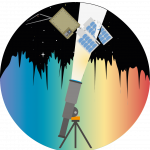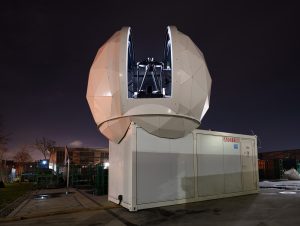
SpecTrackular
Project goals
- Development of a telescope system for spectroscopy analysis of space debris
- Self-learning pointing model
- Improved telescope tracking via orbital data measurement
Description
More satellites have been launched in the year 2023 than any year prior. 40% of all objects currently tracked within earth’s orbit have been sent there in the last four years. An unwanted side effect of this trend is a steady increase in the amount of space debris orbiting earth. Should the trend set in previous years continue, space debris will become an ever increasing threat to satellites. Until there is a global plan to prevent future as well as remove current space debris, an improvement in orbit prediction accuracy is vital. Thereby, unlikely collisions can be detected and the lifetime of satellites extended.

ACINOGS: Optical ground station
SpecTrackular aims to develop a telescope system capable of measuring the orbital path of space debris and allow spectroscopic characterization. Therefore, high-precision pointing and tracking of the telescope system, an improvement of the orbital path based on collected data and a spectroscopic measurement of the debris object are needed. Reflectance spectroscopy requires particularly precise tracking, because the light source, aperture and detector need to be aligned within a few arcseconds.
In order to achieve the required tracking accuracy, a self-learning pointing model will be developed, which can adapt to any emerging misalignment. Using the updated telescope system, the discrepancy between publicly available orbital data and the actual orbit can be measured and integrated into future predictions. The combination of the presented advancements will hopefully lead to a telescope system capable of tracking space debris for minutes at a time, with a tracking accuracy of less than <2” and, thereby, enable spectroscopic measurements. A spectroscopic analysis of the incoming light can give information on the material, pose and rotation of the debris object, which can, in turn, lead to further improvement of the orbit prediction accuracy.
Use case
- Space debris surveillance
Project partners
- ASA Astrosysteme GmbH
Funding
- FFG – Research Promotion Agency, Austrian Space Applications Programme (ASAP)
Contact
Univ.-Prof. Dipl.-Ing. Dr.sc.techn. Georg SchitterDipl.-Ing. Andreas Sinn
Dipl.-Ing. BSc Konstantin Waltenberger
Project Staff
Dipl.-Ing. BSc Konstantin WaltenbergerDipl.-Ing. Andreas Sinn
Time
2024 - 2027Status
ongoingRelated Projects
Further Links
Open Positions
The AMS group offers vacant positions at PhD and PostDoc level